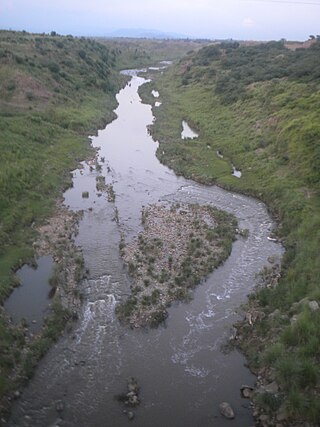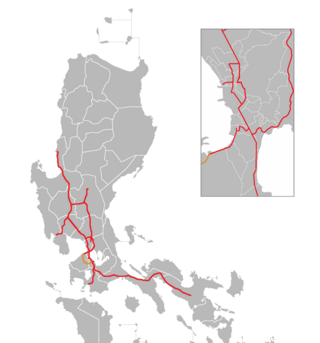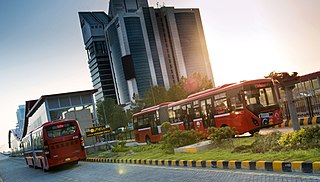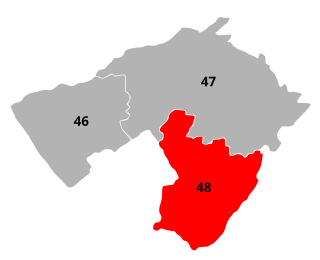Related Research Articles

Murree Road, is a major road that runs from Islamabad and Rawalpindi to Murree in Pakistan. It passes through Rawalpindi's downtown area, and has been a hotspot for various political and social events.
Motorways of Pakistan are a network of multiple-lane, high-speed, controlled-access highways in Pakistan which are owned, maintained, and operated federally by Pakistan's National Highway Authority. At present, 2567 km of motorways are operational, while an additional 1191 km are under construction. Motorways are a part of Pakistan's “National Trade Corridor Project” and “China-Pakistan Belt Road Initiative,” from Khunjerab Pass near the Chinese border to Gwadar in Balochistan. There are a total of 16 motorways, 11 of which are operational, while some are under construction and others are planned.

The M-2 Motorway or the Lahore–Islamabad Motorway is a north–south motorway in Pakistan, connecting Rawalpindi/Islamabad to Lahore, and is the first motorway to have been built in South Asia. The M-2 is 375 km long and located entirely in Punjab. It continues on to eventually become the M-1 motorway, which terminates in Peshawar. The M-2 crosses the junction of M-4 at Pindi Bhattian and M-3 at Dera Saithan Wala. The motorway is also a part of the Asian Highway AH1. The motorway was constructed during Prime Minister Nawaz Sharif's rule and cost over Rs. 60 billion and was opened in November 1997. One of the most expensive motorways in Asia, it also has one of the highest pillared-bridges in Asia at the Khewra Salt Range section.

The M-1 motorway or the Islamabad–Peshawar Motorway is an east–west motorway in Pakistan, connecting Peshawar to Islamabad–Rawalpindi.

Islamabad International Airport is the international airport serving Islamabad, the capital city of Pakistan and Rawalpindi. It is located 25 km (16 mi) south-west of the city, and is accessed via Srinagar Highway.

Islamabad is located in the Pothohar Plateau in the northern part of Pakistan, within the Islamabad Capital Territory. It is a well-organized city divided into different sectors and zones. It was ranked as a Gamma + world city in 2020. The city is home to Pakistan Monument, which is built on top of a hill in Shakarparian, and the Faisal Mosque, one of the largest mosques in South Asia and the sixth -largest mosque as per area in the world. The Capital Development Authority is tasked with developing the city and its facilities.

Lai Nullah, commonly called Nullah Lai, is a rain water fed natural stream flowing through the city of Rawalpindi. Every monsoon season the stream floods after being fed by its catchment basin in the Margalla Hills bordering Islamabad, Pakistan.

The Korang River is a stream in Punjab, Pakistan. It originates from Murree Hills and flows towards Islamabad. Korang Stream along with some other small streams coming from Margalla Hills have been set to form the artificial Rawal Lake in Islamabad. Korang River is the outlet stream of Rawal Dam. This stream crosses Islamabad Express Highway from between Korang Town and Judicial Colony. The terrain of this stream is eye catching and the Loi Bhair Wildlife Safari Park is located on the beautiful terrain of the left bank of Korang Stream. Onward, this stream joins Soan River before reaching the Grand Trunk Road. Just after this point, Lai Nullah also joins Soan River.
On 23 July 2001, Islamabad experienced a record breaking 620 millimetres (24 in) of rainfall, which was the 24 hours heaviest rainfall in Pakistan during the past 100 years. Continuous downpour lasted for about 10 hours from 0600 to 1600 PST in Islamabad and Rawalpindi, caused the worst ever Flash flood in the local stream called Nulla Lai and its tributaries of Rawalpindi, which not only flood the low-lying areas of the twin cities but swept away the banks of the stream and buildings built in the encroachments. Islamabad's twin city, Rawalpindi experienced 335 millimetres (13.2 in) of rain during this event.

The transport system in Islamabad, the capital of Pakistan, connects it with all major cities and towns via regular trains and bus services running mostly from the neighbouring city of Rawalpindi.

The Islamabad Expressway, sometimes also referred to as Islamabad Highway, is a major north–south expressway in Islamabad, Capital Territory, Pakistan. The expressway provides quick access between the Islamabad and Rawalpindi, Punjab, connecting the national capital with the N-5 National Highway. It stretches from Zero Point Interchange with the Kashmir Highway in Islamabad to Rawat, Islamabad Capital Territory on the N-5 National Highway. The total length of the expressway is 28 kilometers (17 mi), with lanes varying from six to ten.

The Bhanupli–Leh line is an under-construction, high-elevation, all-weather, 489 km (304 mi) long, 1,676 mm wide gauge, electrified railway track connecting Bhanupli in Punjab state to Leh in Ladakh union territory of India. It will reduce travel time from New Delhi to Leh to 10 hours. Passing through seismic zone IV and V at an elevation of 600m to 5,360m above sea level, the line will surpass China's Qinghai–Tibet railway to become the highest railway in the world. The Indian Defence Ministry identified this project as one of the four important strategic railway connections to the border with China. The line, with a total length of 489 km (304 mi), including the 13 km (8.1 mi) Leh-Sasherthang rail link, will cost ₹99,000 crore. This includes ₹62,0000 crore for 62 tunnels of total 270 km length, 114 major bridges and 90 minor bridges. The construction phases are:

The Cavite–Laguna Expressway, signed as E3 of the Philippine expressway network, is a partially operational controlled-access toll expressway in the provinces of Cavite and Laguna, Philippines. The construction of the 44.63-kilometer-long (27.73 mi) expressway, which began in July 2019, costs an estimated ₱35.43 billion. Once completed, it will connect the Manila–Cavite Expressway in Kawit to the South Luzon Expressway in Biñan and is expected to ease the traffic congestion in the Cavite–Laguna area, particularly along the Aguinaldo Highway, Governor's Drive, and the Santa Rosa–Tagaytay Road.

The Rawalpindi-Islamabad Metrobus is a 83.6 km (51.9 mi) bus rapid transit system operating in the Islamabad–Rawalpindi metropolitan area of Pakistan. It consists of four routes, namely the Red, Orange, Blue, and Green Lines. The Red and Orange Lines have dedicated lanes with proper stations built along them, while the Blue and Green Lines currently run along the Islamabad Expressway and Srinagar Highway respectively, with regular traffic.
The Kampala–Jinja Expressway, also known as the Jinja–Kampala Expressway, is a proposed four-lane toll highway in Uganda, linking Kampala, the capital and largest city of Uganda, with the city of Jinja in the Eastern Region of Uganda.
Expressways of Pakistan are a network of multiple-lane, high-speed toll highways in Pakistan, which are owned, maintained and operated by various levels of government. All federal expressways are controlled by the National Highway Authority, while others are provincially and municipally controlled. Expressways are usually higher grades than national highways, but differ from motorways by having fewer access restrictions. All federal expressways are pre-fixed with the letter 'E' followed by the unique numerical designation of the specific highway.
The Kampala–Mpigi Expressway, also Busega–Mpigi Expressway, is a four-lane, dual carriage highway under construction in the Central Region of Uganda, connecting, Kampala, the capital city, and Mpigi, the headquarters of Mpigi District.

NA-48 Islamabad-III is a constituency for the National Assembly of Pakistan.
The Margalla Avenue or Margalla Expressway is a 33-kilometer six-lane highway in the Margalla Hills area in the suburbs of Islamabad. It was planned in 1966, but work on it was stalled till 2021. The road is an alternative to the Srinagar Highway, and provides easy access of the tenth and eleventh sectors of Islamabad to the N-5 National Highway. This road is a crucial section of the larger Rawalpindi Ring Road project as it connects the town of Sangjani to the town of Barakahu.
Karnal Sher Khan Shaheed Road, previously known as the IJP Road, or the Inter Junction Point Road, is one of the busiest roads in the Islamabad–Rawalpindi metropolitan area in Pakistan, connecting Islamabad to Rawalpindi. It also serves as a route for traffic coming from Punjab and Azad Kashmir going towards Taxila, Attock, and onwards to Khyber Pakhtunkhwa. It is named IJ Principle Road because it is the road that was going to be between the never-built Sector J and Sector I of Islamabad.
References
- ↑ "Construction of Lai Expressway | PPP". ppp.punjab.gov.pk. Archived from the original on 2022-06-19. Retrieved 2022-07-31.
- ↑ "PM for early completion of RUDA, CBD, Nullah Lai Expressway projects". Associated Press of Pakistan . 6 January 2022. Retrieved 6 October 2022.
- ↑ "Work on Leh Expressway to begin next month". The Express Tribune . 7 March 2022. Retrieved 6 October 2022.
- ↑ "'Work on Nullah Leh Expressway to kick off soon'". The News International . 10 October 2021. Retrieved 6 October 2021.